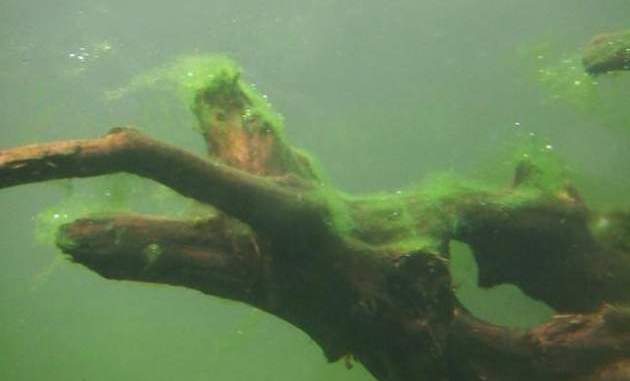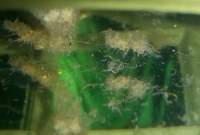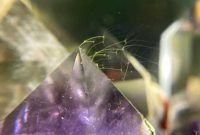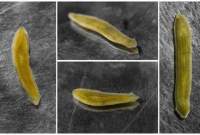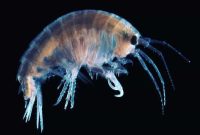The Algae curse is familiar for most aquarists and becomes a tough obstacle for “beginners.” Without any experience and less knowledge, making they feel so frustrated. That is why learning deeper, especially about potential problems, before building a living aquarium is necessary.
Although sometimes an advanced also find out a new complex problem, push them to search for new ways to solve it. The point is a true aquascaper must learn sustainability to preserve their aquarium.
As we know, the aquarium algae come with many variants; there is a hairy look, a dusty view, seem like threads, brown tint, greenish, reddish, and many more.
The hair green color algae are generally present in the young tank; if you are a newbie, this article will be valuable because it has closely related.
Many articles on the internet talk about green hair algae as an independent species, whereas they consist of four genera at least.
And at this moment, we will share information that we got about one of them, “Rhizoclonium algae,” after we have previously written the other three types.
TABLE OF CONTENTS
What Is Rhizoclonium Algae?
These algae are a part of freshwater green algae under the cladophoracea family, which means still closely relatives to cladophora algae.
Rhizoclonium Kützing is their genus scientific name, and they are unicellular. Based on the information from Wikipedia, they consist of 5 species, including Rhizoclonium riparium, R. grande, R. hieroglyphicum, R. sp. TKSHCL-1301, and R. sp. LB1523.
They have pale-light green or even brown color appearances, with slimy texture and filamentous shapes.
Their slender, unbranched filaments can grow up to 2 inches (5 centimeters). When rhizoclonium algae arise inside an aquarium, they usually look like a thread, then form a large tangled coarse mat in a few weeks or even days.
Under a microscope, you will see them having large, cylindrical, and long cells. It generally is longer, about 2-4 times, than broad.
In the aquarium, they usually grow by attaching to some objects’ surface, such as plant leaves, decorations, and substrates. Whilst, the wild forms are very different. In nature, these algae are frequently found as floating mats in quiet stagnant water where it is helped by the oxygen they produce or as ropelike strands inflowing streams. Sometimes they also can intermix with other filamentous green algae.
Like their cousin, the rhizoclonium prefers to inhabit the shallow and hard water environment. According to the study, they known can thrive well in diluted seawater. Rizhoclonium can reproduce in two ways akinetes and fragmentation.
Read Also: How To Fight Spirogyra Algae In Your Aquarium
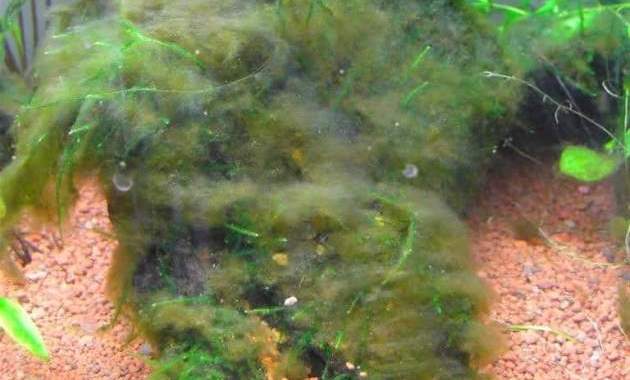
Is The Green Rhizoclonium Algae Bad For Plants?
Algae are an entity that has a nasty effect on any aquatic plant. They were labeled as a nuisance pest in the aquarium world and accepted universally by all the tank hobbyists long ago.
They are known can slow down plants growth. In some cases, these species can be a reason that causes more severe problems. Because they live by attaching to them, absorbing more nutrients and light, then propagating themselves quickly.
If left untreated, their population blooms rapidly, presents in every inch across the tank, and shows green fluffy masses view to the outside.
This is clearly harmful to the plants; the spaces increasingly crowded, nutrients are dropping, and less lighting, making the hope to have a healthy and beautiful planted tank is go away. Only one solution against it is rescape your aquarium.
Nevertheless, if you have some plans to deal with them before, this worst thing will never happen.
So, since you do some action to restrain their population, your tank will be always stand in excellent and stable performance, offering a magnificent display.
Read Also: Defeating Oedogonium Algae Inside The Aquarium
Is The Rhizoclonium Algae Harm For Fish?
Such as other green hair algae, they can bring some benefits and disadvantages for fish; however, in reality, they absolutely lead to more issues.
They do not straightforwardly harm the fish; instead, they create some problems in many ways which can affect them. For the sample, they can clog filter where it stops the water cycle, as the results the water quality is changed.
A massive colony that forms a thick mat is pretty dangerous. It can make the fishes get entangled and can not escape from there, especially for small size.
When they grow uncontrolled, they probably cover the surfaces, making the plants under side difficult to photosynthesize. It will reduce the oxygen significantly; also, it gives the fish more trouble when they try to reach the surfaces for breathing, making them suffer more.
Vice versa, if they are grow-handled, only a few patches appear in the tank; you should not worry about that. It’s normal, even offering a benefit for your fish. There are some types of fish and other aquarium creatures consuming these algae as their primary diet in the wild.
So, algae will become an extra food for them, and the algivores happily swim around the fish tank to hunt these snacks.
However, some tank keepers may not want even though any tiny piece of algae to arise in their tank and then choose to eradicate it until there is nothing left.
Read Also: Advice To Dealing With Cladophora Algae In The Aquarium
Common Causes Of Rhizoclonium Algae
You might not get a domination position in-game to conquer these algae if you do not understand the primary keys that invite them to develop.
At least, there are four main reasons causing the rhizoclonium algae to thrive well in your freshwater aquarium:
Newer Setup
The unfinished nitrogen cycle in the new tank is the top reason for this outbreak. The high concentration of this substance at the beginning tank setup is slightly hard to restrain, especially for the new aquarium keepers with low experience.
This chapter is a vulnerable phase for the tank populations. Suppose you can not maintain them as well as they need. In that case, the rhizoclonium will invade your aquarium easily, or even other algae types come to join because it is a perfect environment for some algae types to grow.
Low Maintenance
Some people with many activities outside or are busy might can not take a little time to care for and maintain their tank, creating an imbalance in this ecosystem.
An abandoned tank will be rich with organic waste, having poorly water parameters, lower nutrients, some dead plants or fish, and the aquarium gear might be broken.
The unhealthy aquarium will drive the rhizoclonium algae to rise, and if they leave there without some cure, the destructive plague will arrive soon in your aquarium.
Read Also: How To Kill Staghorn Algae
Lower Carbon Dioxide Content
It’s the most common reason for algae problems. Plants that do not get sufficient CO2 will grow in deficiencies. As time goes by, they might melt, and algae blooms appear.
This condition pushes them to compete for each other to consume more to survive; it’s generally happened in an aquarium with many plants.
Poor Water Flow
Slowly water flow rate usually can be a way that is causing alga. A not correct or older filter gear utilization creates a sluggish water movement, making some spots not supply enough fresh water or even unsupplied (dead zone).
This makes CO2 and nutrient circulation unspread to entire zones, creating an area around the plants is poorly; instead, the algae will start to present.
How To Control The Rhizoclonium Algae Growth In Your Aquarium
Preventive measures are the right methods to keep away your tank from them. By doing the series of these steps, the chance for algae to live is very insignificant. Here is the list to avoid your fish tank from these algae:

Put Some Species That Eat These Algae
Algae eaters still become a slightly powerful weapon against most of the algae. They can help you to avoid algae by their consuming habit that have more interest to eat them than other species.
Green hair algae group is preferred by most algivores including rhizoclonium, Siamese algae eater, Amano shrimp, nerite snail, otocinclus, and dwarf shrimp species is a proper pet to add to your aquarium.
They would take some action swiftly when found a few clumps of algae, then remove them each by each. Keeping algivores are offering beneficial for low-med cases, and give more entertainment for the owner by their habit and appearances, making any people does not feel bored to watching your freshwater tank.
Read Also: Is Red Spot Algae Dangerous?
Passed The Nitrogen Cycle As Well
It’s a very crucial moment when you build a planted tank. You need more effort and patience in this phase.
You might observe the tank in high intensity, if there is an error such as water flowing or lighting rates, fix it soon, do not let it as there. To achieve the mature ones, at least you need one month, so enjoy this process and keep learning.
Pro tips: avoid using base fertilizer, because it contains high ammonia, nitrite, and nitrogen content. Instead, use high-quality soil such as Fluval Stratum. It is made from high-quality mineral-rich volcanic soil and safe for fish and shrimps, so more safe and surely offers to pass this cycle successfully.
The second tip is to add more algae eater crew. We usually use more dwarf shrimps such as red cherry shrimp to remove algae and leave them in the tank with a small food portion or even nothing else. But, you can decide by your own self to choose your favorite algivores.
Provide Correct Doses
Make sure to supply sufficient carbon dioxide, fertilizers, and lighting power that fit with your tank size and population.
This factor is important, it can avoid any plants inside the tank to compete and receive its amounts as they require to photosynthesize.
You have to deeply understand what kind of your tank setup type, the plants’ type and their number, than the inhabitant that live on there later.
After that, you will find the correct tools and concepts this tank requires to run. This is a standard formula that we follow when building an aquascape:
- Carbon Dioxide= 20-30 mg/l
- Nitrate= 10-25 mg/l
- Magnesium= >10 mg/l
- Potassium= 5-10 mg/l
- PH : 7-7.5
- Phosphate= 0.1-1 mg/l
Turn on the lighting for only six-hour per day during this cycle phase. When the tank environment gets matured without any issues, you can start to up the daily lighting period by half an hour per week until a standard lighting duration which is about 8-10 hours. Use this lighting calculator to easily find out the strength light category that you run.
Read Also: The Best Ways To Beat Fuzz Algae In The Aquarium
Do A Routine Maintenance
Every aquascape has to need a regular maintenance session. Without it, many problems will visit it early and hard to resolve.
A tropical tank with a perfect maintenance cycle will look more clean, stable, and the populations will be healthy. You are probably spending a few hours on holiday to perform this. Below are several tasks that generally during this job:
Pruning the dense plant clumps is the first duty that you can do. By cutting the overgrowth plants, the new leaves will vegetate, parts of the underneath can grow optimally and look tidy. Utilization of an aquascape scissor is recommended to doing this; you may have another favorite one.
Pick up any debris and waste on the substrate is a priority in regular maintenance; you need a siphoning tool to clean up the bottom areas. It helps to easiest suck off any dirt and minimize crashing the objects or tearing out the leaf.
Wiping any pieces of equipment and glass is the next move; you require a magnetic aquarium cleaner and brush. It is simple just rub and scratch the stain, but keep be careful.
Then, substitute the old water about 30% (water change) to stable the quality. It would be better if you used distilled water; it’s safer than tap water which usually contains many harmful substances. You can produce it using a RODI water converter for aquarium use that sells on trades.
Once the series of tasks above is complete, add a few doses of liquid fertilizer and make sure if you install a CO2 to switch on back. It will give more energy to plants.
Keep Watch Out
Continuously monitoring your tank condition is very important; it helps prevent any issues that might come.
You should apply several gears; it can be useful to observe the aquarium environment in real-time. A thermometer, nutrients test kit, Carbon dioxide checker, and pH meter are some tools you need and are commonly available in most stores.
Pro tips: we advised to use a canister filter and innovative LED tank; it offers benefits such as holding CO2 tightly, lowering the dead zones rate, and supplying the light period and intensity that you can adjust simply.
Read Also: How To Stop Green Dust Algae Grow In The Aquarium
Eliminating The Rhizoclonium Algae Inside The Aquarium
This section is something that probably you are looking for; it discusses methods of getting rid of these green hair algae species.
Here are some techniques that you can perform to cure and kills them:
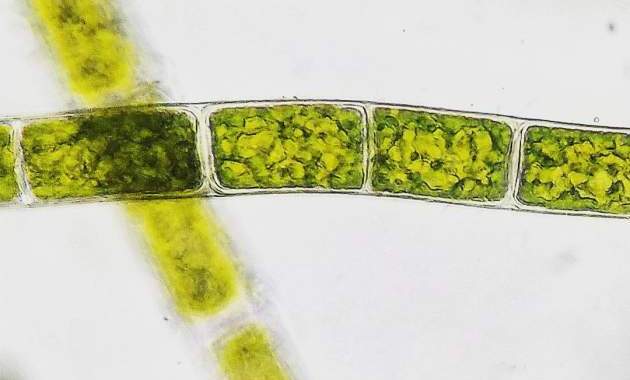
Remove Them Manually
It is still practical and quite efficacious to eradicate the small-medium plague. It also tends to be cheap than other treatments; on the contrary, you have to emit more effort and time.
Firstly, prepare an algae scraper or something identical, such as a toothbrush. Then start to scrub them smoothly as well as possible, ensure the spores do not be straggle, use a net to pick up the shred. If there is a floating mat form, those also can be used to remove them.
It may not clean rhizoclonium algae entirely across the aquarium, so you should black out your tank for three or more, depending on the cases’ level. Throughout this process, feed your fish sufficiently (if you keep shrimp tank, do not feed them), turn off the CO2 and light, use a thick blanket, do not add any fertilizer, apply an air pump to provide oxygen.
When it is over, pull out any dead algae and reduce the water by around 50% (only 10% for shrimptank). Fill it with new fresh water, turn off the air pump, then switch on the filter and lamp again. Putting more algae eaters is effective in depriving the remains. Combining it with boosting carbon dioxide and nutrients rate can promote the effect.
Read Also: 5 Effective Ways To Get Rid Of Ramshorn Snails In The Aquarium
Exterminate Algae With Removal Products
Nowadays, many products on the trades can instantly kill most algae types, including these ones. It sells in various prices and sizes; the most commonly used is ‘Seachem Flourish Excel,’ it is a liquid carbon that can drop the algae ages significantly.
How to apply it is easy; just fill up a syringe with about 3-5 ml of this liquid shoot it out straight to the algae mass afterward.
For the other products, you can use ‘API Algaefix‘ or ‘Tetra Algae Control‘; read the instructions before use. Those products are secure for fish and plants. So choose one that you are interested in.

